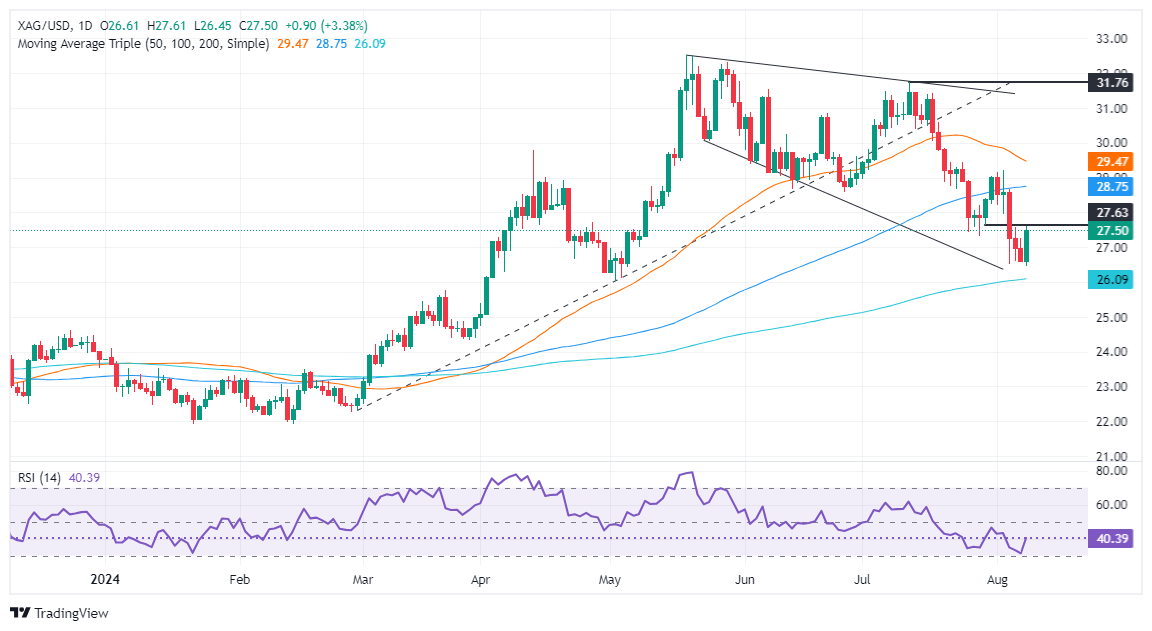Silver Price Forecast: XAG/USD rallies over 3.50% above $27.00
- Silver trades at $27.49, rising over 3.50% after reclaiming the $27.00 level.
- Path of least resistance remains bearish; below $27.00 targets $26.45 and $26.11 support levels.
- Above $27.56, resistance levels are $28.00 and the August 5 high at $28.67.
Silver price surged on Thursday and gained over 3.50% as traders reclaimed the $27.00 figure although strong US data, bolstered the Greenback. Despite that, the XAG/USD bounced off weekly lows of $26.45 and hit a new weekly high before stabilizing at the current spot price. Silver trades at $27.49 as Friday’s Asian session begins
XAG/USD Price Forecast: Technical outlook
Silver prices climbed above $27.00 yet remain below the 100- and 50-day moving averages (DMAs) at $28.76 and $29.79, hinting that sellers are in control. The Relative Strength Index (RSI), which remains bearish, further confirms this.
Hence, the path of least resistance is tilted to the downside. if XAG/USD drops below $27.00, the next support would be the weekly low of $26.45. On further losses, the 200-DMA at $26.11 emerges as the next support, followed by the psychological $26.00 figure.
Conversely, if XAG/USD buyers reclaim $27.56, the next resistance would be the $28.00 mark ahead of the August 5 high at $28.67.
XAG/USD Price Action – Daily Chart

Silver FAQs
Silver is a precious metal highly traded among investors. It has been historically used as a store of value and a medium of exchange. Although less popular than Gold, traders may turn to Silver to diversify their investment portfolio, for its intrinsic value or as a potential hedge during high-inflation periods. Investors can buy physical Silver, in coins or in bars, or trade it through vehicles such as Exchange Traded Funds, which track its price on international markets.
Silver prices can move due to a wide range of factors. Geopolitical instability or fears of a deep recession can make Silver price escalate due to its safe-haven status, although to a lesser extent than Gold's. As a yieldless asset, Silver tends to rise with lower interest rates. Its moves also depend on how the US Dollar (USD) behaves as the asset is priced in dollars (XAG/USD). A strong Dollar tends to keep the price of Silver at bay, whereas a weaker Dollar is likely to propel prices up. Other factors such as investment demand, mining supply – Silver is much more abundant than Gold – and recycling rates can also affect prices.
Silver is widely used in industry, particularly in sectors such as electronics or solar energy, as it has one of the highest electric conductivity of all metals – more than Copper and Gold. A surge in demand can increase prices, while a decline tends to lower them. Dynamics in the US, Chinese and Indian economies can also contribute to price swings: for the US and particularly China, their big industrial sectors use Silver in various processes; in India, consumers’ demand for the precious metal for jewellery also plays a key role in setting prices.
Silver prices tend to follow Gold's moves. When Gold prices rise, Silver typically follows suit, as their status as safe-haven assets is similar. The Gold/Silver ratio, which shows the number of ounces of Silver needed to equal the value of one ounce of Gold, may help to determine the relative valuation between both metals. Some investors may consider a high ratio as an indicator that Silver is undervalued, or Gold is overvalued. On the contrary, a low ratio might suggest that Gold is undervalued relative to Silver.